2022 Ducati Streetfighter V2 Review - First Ride

Performance that could shake up the 900 naked bike class
The timing couldn’t have been better with the 2022 Ducati Streetfighter V2 introduction. As frequent Motorcycle.com readers know, we’ve just spent the last five months testing every class of the ultra-hot naked motorcycle market. What we’ve learned from those shootouts is that, no matter the displacement, naked bikes are more fun than humans should be allowed. However, for this tester, nothing compares to the combination of practicality and fun of the bikes in the 900(ish) cc category. With the torque to easily handle the everyday urban bump-and-grind, these bikes also have the power and handling to peg the Fun O Meter when the going gets twisty – on both the street and the track. And now Ducati has stepped in to reshuffle the class with a motorcycle that allows the Ducati Monster to be the roadster it always wanted to be, by giving it a sibling that takes a more bare-knuckled approach to the category thanks to the company’s “fight formula” first revealed with the Streetfighter V4.
2021 Lightweight Naked Bike Shootout Smackdown Comparo Review
2021 MO Middleweight Naked Bike Shootout – Six Bikes!
2021 Six-Way, 900(Ish)Cc Naked Bike Shootout!
Battle Royale: 7-Way Heavyweight Naked Bike Shootout – Street
2022 Ducati Streetfighter V2
Editor Score: 91%
| Engine | 18/20 | Suspension | 13.5/15 | Transmission | 9/10 |
| Brakes | 8/10 | Instruments | 7.5/5 | Ergonomics | 9/10 |
| Appearance | 9/10 | Desirability | 9/10 | Value | 8/10 |
+ Highs
- A refined, beast of a V-Twin
- Stable chassis
- Almost perfect riding position
– Sighs
- Needs more aggressive brake pads
- TFT could be bigger
- A bike in this price range should have a fuel gauge, cruise control, and heated grips
Bad to the bone
The Streetfighter V2 inherits its street cred from its similarly-sized sibling, the Panigale V2. In fact, Ducati points out the Streetfighter is essentially a Panigale V2 stripped of its supersport bodywork and graced with a couple of other modifications. Here’s what goes into the making of this beast.
The engine is the 955cc Superquadro 90° V-Twin that powers the Panigale V2. The bore and stroke remain 100 mm x 60.8 mm. Although the Streetfighter shares the same exhaust, the structure of the front end doesn’t allow for the ram-air intakes present on the Panigale. This change is likely responsible for the two-horsepower drop to 153 hp claimed by Ducati. The torque drops a similar amount to 74.8 lb-ft. Still, this reduction represents just a 1.3 % change in horsepower between the two models and will likely go unnoticed by most, if not all, riders. To give a more spirited response to throttle inputs, two teeth were added to the rear sprocket, sacrificing outright top speed to bottom-end and mid-range acceleration.
The engine and chassis retain their structural relationship, with the engine rotated 21° rearward to contribute to the bike’s short 58.7-in. wheelbase. One notable change to the chassis is that the single-sided swingarm bolted to the rear of the engine is 0.6 in. longer than the Panigale’s for increased stability. Delivering power to the rear wheel is a six-speed transmission that is controlled by an anti-hopping wet clutch, featuring a servo system which minimizes the torque transferred into the engine during hard deceleration. Gear changes are facilitated by a hydraulic clutch or an up/down quickshifter as a standard feature.
The electronics package is controlled by a 6-axis IMU which allows for the latest version of Ducati’s rider aids: ABS Cornering EVO, Ducati Traction Control (DTC) EVO 2, Ducati Wheelie Control (DWC) EVO, Ducati Quick Shift up/down (DQS) EVO 2, and Engine Brake Control (EBC) EVO. Three ride modes (Sport, Road, and Wet) vary the level of intervention that the electronics deliver and even reduce the power output in the wet.
Making the interface to the tarmac is a set of Pirelli Diablo Rosso IV tires, and a fully-adjustable 43mm Showa Big Piston Fork along with a Sachs shock. Braking is handled by the same system as on the Panigale V2 – although with a slightly less-aggressive pad compound.
Finally, we arrive at the styling. The Streetfighter V2 shares a similar profile and face as its larger V4 sibling. Side-by-side, the family resemblance is unmistakable. However, there are some differences. For example, the V2’s TFT display is only 4.3 in., but it still shares the same intuitive menu system for adjusting the motorcycle’s parameters. There are, however, a couple of notable absences. There is no fuel gauge, which seems silly with this graphically-driven instrumentation. Also, cruise control and heated grips are not offered. For a bike priced at almost $17,000, these seem to be major oversights. Just as they are on the V4.
Aside from these miscues, the Streetfighter V2 delivers the quality fit-and-finish you would expect from Ducati’s premium reputation.
Out on the street
If there is a special heaven for motorcyclists, it is probably based on the roads of Andalusia. The undulating, mostly pristine pavement puts our local testing haunts to shame, and the scenery – when I could spare a half-second to glance at it – was epic. The group of North American journalists took to the hill country directly north of our Monteblanco Circuit base of operations for a few hours of riding that took my breath away. While we didn’t get any extended freeway riding, we checked off most other street-riding categories. From small towns to high-speed rolling sweepers to tight and technical single-lane roads, the Ducati Streetfighter V2 handled it all.
The engine sets the tone for the ride. While a little abrupt at lower rpm, I kept the ride mode in Sport for the majority of the ride because the throttle response was quite smooth and directly matched my inputs at the grip’s ride-by-wire throttle. At any speed above the neighborhood of 2,000 rpm, the Superquadro engine is happy to pull out of corners with enough thrust to suit the Streetfighter name. Wind it up above 6,500, and the engine really begins to sing. The quickshifter is super smooth, though it does prefer that the engine be in the mid-range and above for more seamless downshifts.
Be it bending into a high-speed sweeper or charging a tight corner hard on the brakes, the Streetfighter goes exactly where you want it to and doesn’t wrestle with you if you’re trailing the brakes to the apex. Some credit for this goes to the excellent Pirelli Diablo Rosso IV tires the Ducati is equipped with. As stated above, the brakes were lifted from the Panigale V2, and on the street, I never encountered a situation where I felt I needed more braking power or feedback from the Brembo M4.32 calipers.
The Streetfighter’s riding position is on the sporty side of a standard sit up, with the appropriately wide handlebar giving plenty of leverage when needed. The mirrors were a bit on the tight side and required some fiddling to minimize the view of my elbows while still gathering essential information. Bar end mirrors will probably be popular with this bike.
Towards the latter portions of the street ride, I was happy to finally encounter some rough pavement. Billiard-smooth Spanish tarmac is a joy to ride on, but it doesn’t give an accurate representation of what the suspenders will be like back in the U.S. As expected, the settings were on the firm side; however, both the Showa BPF and the Sachs shock offer enough adjustability that I suspect the right compromise can be found for the bumpy roads MO tests frequently traverse.
And now we come to the elephant in the room when it concerns the Superquadro engine. When I first started riding the Streetfighter through the town on our way to rural highways, I momentarily considered that somebody may have punked me and turned on the seat heater before the ride (not that any MO staffer would ever do a childish thing like that to one of their competitors). Immediately, I dismissed that thought, and memories of toasted buns flowed back. Fortunately, the heat from the rear cylinder – possibly thanks to the thicker padding on the Streetfighter’s seat – never became oppressive. I was aware of the warmth but not annoyed by it. The caveat is, though, the ambient temperature was around 70° F. On a 100° day, I might be singing a different tune. Still, the heat was not as bad as my memories of the Superquadro engine.
The Monteblanco Circuit
While not carrying the same status as the European tracks featured on the international racing calendar, the Monteblanco Circuit offered an ideal environment to push the limits of the Streetfighter V2 on the Diablo Rosso IV street tires. I’m sure Ducati’s goals were two-fold: show the press how capable the V2 is out of the box and highlight that naked bikes allow for tremendous fun in a closed course environment. The Monteblanco Circuit features a great balance of sweeping bends and tight, low-speed corners that are capped off with a one-kilometer (0.6 mi.) front straight, leading into a second gear corner.
The track allows the Superquadro to really stretch its legs and exploit the top end power that are the benefit of its superbike roots. The quickshifter is silky smooth in this dynamic environment. Coming out of the final, 90° corner hard on the gas highlights several things. First, how cleanly the engine accepts throttle inputs when twisted open at an exit. Second, the Rosso IV tires betray their street orientation by beginning to slip, and finally, the traction control gets to strut its stuff.
Now, I’m not known as being the most aggressive rider in getting on the gas, preferring a roll instead of a whack with throttle inputs. However, seeing that front straight extending in front of me got my juices flowing and made me crank on the grip in an ever more aggressive manner lap after lap. The engine comes alive from 7,000-9,000 and gets really frisky above 9,000, where the torque curve flattens out but the horsepower keeps climbing. My reward for pinning the throttle was seeing 150 mph (242 kph, actually) by the time I reached the brake markers. The more talented journos who carried more speed out of the final corner were peaking at 5-10 mph faster than me. Still, 150 mph is plenty fast without any wind protection.
My thoughts when charging down the straight came at me staccato fashioned. The seat back is good. (Keeps me from sliding.) I can tuck in well. (There is enough room for my almost six-foot frame to tuck in on top of the tank.) Why isn’t the TFT bigger? (It would make it easier to see my shift points.) Oh my god, it’s time to slow down.
Which leads us into the biggest flaw of the Streetfighter at the track. Ducati chose to put a less aggressive pad in the M4.32s, and it shows. While it was possible to haul the V2 down from speed, the initial bite of the brakes left a lot to be desired, and with a strong enough squeeze, the bike did slow enough for the first corner. However, I overshot my turn-in mark for the first couple of laps until I got a handle on the braking power.
Since the brakes were lifted directly from the Panigale V2, a little research reveals that my feelings fall in line with Troy’s experience with them at Jerez (just minus the initial bite): “[T]here’s nothing inherently wrong with the Brembo setup, as the initial bite and power of the binders is strong and communicative, but for my personal riding style, I’d prefer to keep the initial bite and add even more stopping power.” Even though I’m not as hard on the brakes as Troy, more power gets my vote, too. Since I had no issues with the brakes on the street, I’d start with more aggressive pads and move on from there.
When it comes time to turn the Streetfighter, its Panigale roots are on full display – only you’re in a more upright riding position with a wide handlebar to lever the bike onto its side. Once leaned over, the suspension, which the Ducati techs set up for the track, takes care of the rest. Still, it’s the act of slowing down and actually getting the bike leaned over that bears mentioning, the front-end feel is phenomenal, making a Walter Mitty of a track rider, like myself, feel like a hero regardless of whether the corner was a fast sweeper or a tight first gear hairpin. Because I knew what was going on at the front, I had no qualms about trail braking deep into the corner. Side-to-side transitions were taken with laser-like accuracy. I literally felt like the Streetfighter V2 was making me a better rider by increasing my confidence.
Crossing the finish line
Having ridden the Streetfighter V2’s elder sibling, the Streetfighter V4 S, at the track only a few weeks prior to this introduction, the differences are very clear. The V4 S feels like it is only restrained from shooting you into another dimension by its electronics, while the V2 is more focused on having a good time. Where the V4 S left me drained at the end of a session on a less technical and physically challenging track, the Streetfighter V2 left me feeling less beat up. The Streetfighter V2 is easier to ride, and in my opinion, it is better suited to both the type of street riding and track riding that I enjoy.
As I said before, the Streetfighter V2 inspires confidence on the track. Out in the real world, its good looks would be a source of pride, while the usability of the bike would make it happy to troll along on the daily commute and then go strafe apexes on the weekends. Ducati has taken its fight formula and dialed it back from 11 with the Streetfighter V2, creating a motorcycle that will allow more riders to tap more of its potential. And that’s my definition of a good time. Given the strength of this new member to the 900(ish) naked bike class, we may have to stage another shootout to see if the rankings are, as I predict, shaken up.
The 2022 Ducati Streetfighter V2 will be available in showrooms in December 2021 for a MSRP of $16,995. Hopefully, you like Ducati red, because that’s the only color offered.
In Gear – Street

Helmet: Shoei X-Fourteen
Jacket: Alpinestars Oscar Charlie
Gloves: Alpinestars SPX Air Carbon v2
Jeans: Alpinestars (Discontinued)
Boots: Alpinestars Supertech-R
In Gear – Track
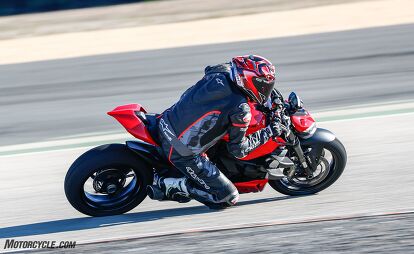
Helmet: Shoei X-Fourteen
Leathers: Alpinestars GP Pro V2
Gloves: Alpinestars Supertech
Boots: Alpinestars Supertech-R
2022 Ducati Streetfighter V2 Specifications | |
|---|---|
| Price: | $16,995 |
| Engine Type | Superquadro: 90 ° V2, liquid cooled |
| Valve Train | Desmodromic 4 valves per cylinder |
| Bore x Stroke | 100 mm x 60.8 mm |
| Compression Ratio | 12.5:1 |
| Induction | Electronic fuel injection system. Twin injectors per cylinder. Full ride-by-wire elliptical throttle bodies |
| Final Drive | Chain |
| Transmission | 6 speed with Ducati Quick Shift (DQS) up/down EVO 2 |
| Clutch | Hydraulically controlled slipper and self-servo wet multiplate clutch. Self bleeding master cylinder |
| Front Suspension | Fully adjustable Showa BPF fork. 43 mm chromed inner tubes |
| Rear Suspension | Fully adjustable Sachs unit. Aluminum single- sided swingarm |
| Front Brake | Brembo Monobloc M4.32 4-piston callipers with Bosch Cornering ABS EVO. Self bleeding master cylinder |
| Rear Brake | 245 mm disc, 2-piston calliper with Bosch Cornering ABS EVO |
| Front Tire | Pirelli Diablo Rosso IV 120/70 ZR17M |
| Rear Tire | Pirelli Diablo Rosso IV 180/60 ZR17M |
| Rake (castor angle) | 24° |
| Seat Height | 33.3 inches |
| Wheelbase | 57.7 inches |
| Fuel Capacity | 4.5 gallons |
| Curb Weight | 441 lbs. (claimed) |
| Colors | Red |
We are committed to finding, researching, and recommending the best products. We earn commissions from purchases you make using the retail links in our product reviews. Learn more about how this works.
Become a Motorcycle.com insider. Get the latest motorcycle news first by subscribing to our newsletter here.

Like most of the best happenings in his life, Evans stumbled into his motojournalism career. While on his way to a planned life in academia, he applied for a job at a motorcycle magazine, thinking he’d get the opportunity to write some freelance articles. Instead, he was offered a full-time job in which he discovered he could actually get paid to ride other people’s motorcycles – and he’s never looked back. Over the 25 years he’s been in the motorcycle industry, Evans has written two books, 101 Sportbike Performance Projects and How to Modify Your Metric Cruiser, and has ridden just about every production motorcycle manufactured. Evans has a deep love of motorcycles and believes they are a force for good in the world.
More by Evans Brasfield

















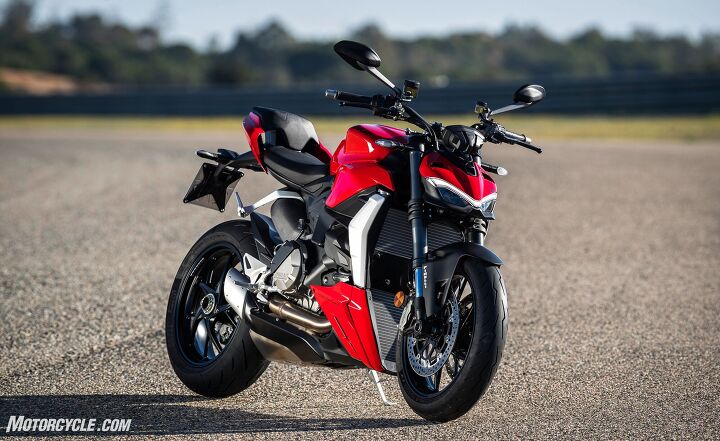

































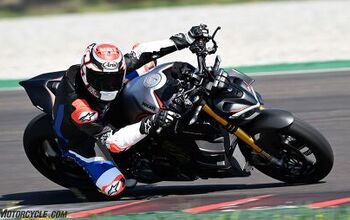
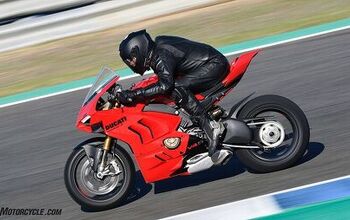
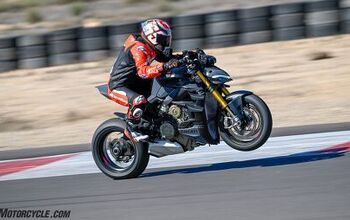
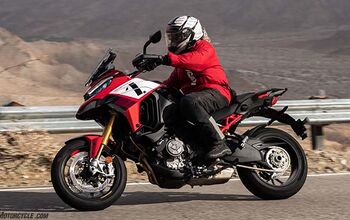












Comments
Join the conversation
I'd love to take one out for a day in the twisties, but long term, no.
I wonder how this would stack up against the OG 1098 streetfighter, something like the old Duc SS and 916 vs the SS 950? I bet the the meaner with age 1098 would show the V2 what for on a canyon road or track.